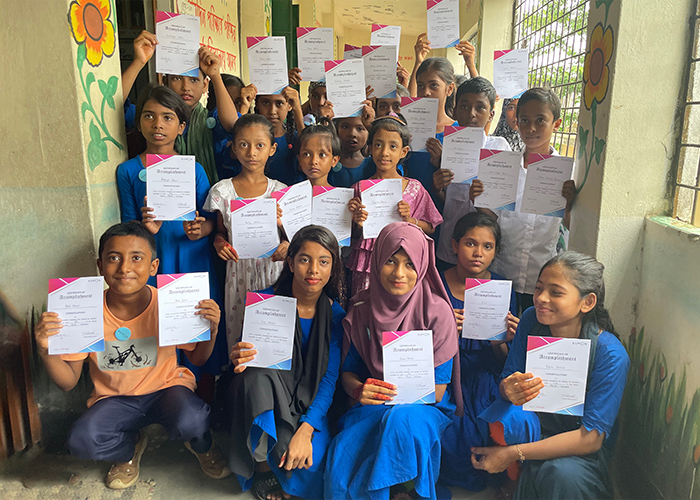Why the Kumon Method was introduced to Sonpara Elementary School—BSEZ President Kawachi’s passion
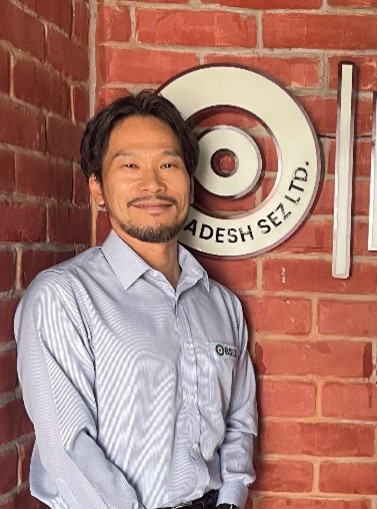
This project began with BSEZ President Kawachi’s deep passion for the region. He was assigned to this area in October 2021 to oversee the development of the BSEZ. He visited the site daily to explore the surroundings of the BSEZ.
When he visited a nearby market cafeteria for lunch, he observed elementary school-aged children working to support their families instead of attending school. Additionally, during his visits to neighboring elementary schools, he discovered children whose families could not afford to purchase uniforms because they had to use the government-provided uniform funds to cover basic living expenses. He remarked, “I confronted the harsh reality faced by local children.”
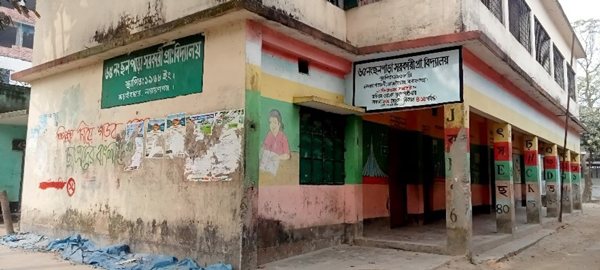
President Kawachi found himself pondering, “Can BSEZ truly bring happiness to these children?” He believed that the industrial park would be a project that would enrich the country; however, he was acutely aware of the children living in disadvantaged conditions surrounding BSEZ. Faced with this dilemma, President Kawachi resolved to offer educational opportunities for local children as part of their corporate social responsibility (CSR) project.
In the past, the company typically contributed money or goods to local communities in other countries as part of its CSR initiatives. However, with the aim of “providing value that will remain in the community,” President Kawachi decided to support the implementation of the Kumon Method in a nearby elementary school, creating educational opportunities for children.
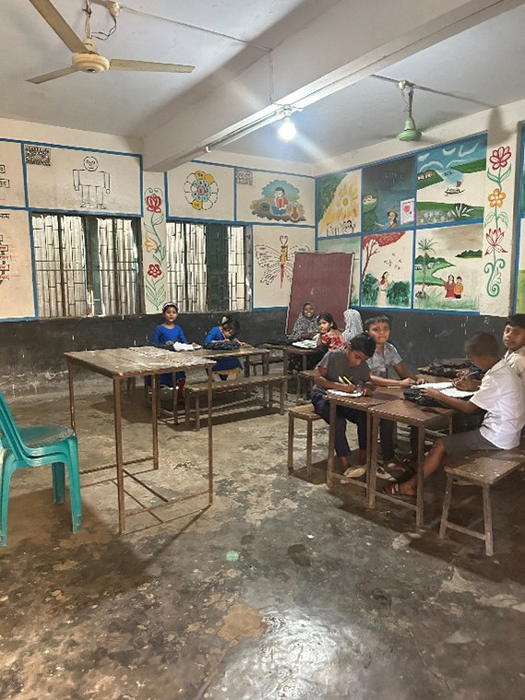
Lighting was installed in each classroom through this project.
President Kawachi stated, “I have three children, all of whom have studied Kumon since the early grades of elementary school. They are now grown, but I believe that through the Kumon Method, they have developed the resilience to persevere and never give up. I am inspired by their ability to think independently and grow each day. I hope that children in Bangladesh will also learn the importance of persistence and the joy of personal growth through their Kumon studies, enabling them to shape their own futures.”
Various hurdles had to be overcome to introduce the Kumon Method to a public elementary school, including the challenge posed by the local board of education’s assertion that public elementary schools would not accept any curriculum other than that mandated by the government. Ultimately, however, the board and the school reached an agreement, and students began the Kumon program at Sonpara Elementary School in February 2024.
Changes that occurred in the elementary school during the year
Sonpara Elementary School utilizes KUMON CONNECT, a Kumon learning system accessible on tablet devices. Consequently, BSEZ offered support to establish a conducive learning environment, which included the deployment of tablet terminals, as well as the provision of electricity, Wi-Fi, and storage facilities for the tablets. Training for the schoolteachers was conducted by BRAC Kumon Limited, the organization responsible for promoting and developing the Kumon Method in the region. They continue to provide ongoing support even after the learning program has commenced.
One year has passed since the introduction of Kumon Method. We would like to share the changes that have occurred in the school through the comments of schoolteachers, students, and BSEZ project staff.
■Children began attending school daily and became increasingly motivated to learn
We spoke with the schoolteachers who oversaw the Kumon program.
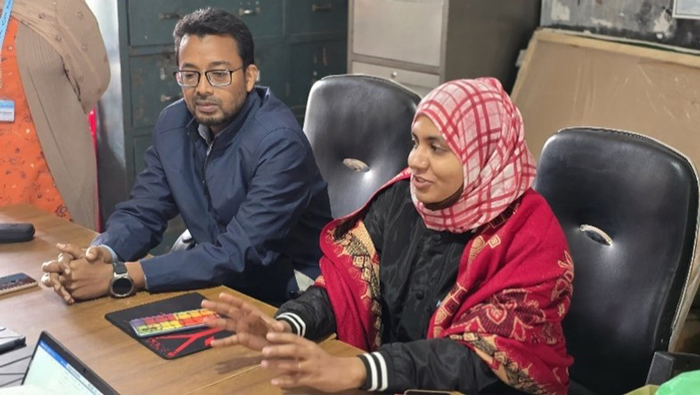
Mr. Tamzid: The area is economically disadvantaged, and many children from low-income families attend this school. Previously, numerous students struggled to concentrate and often missed classes for several days for various reasons after attending school just once. However, since the implementation of the Kumon Method, students have begun attending school daily. Learning on a tablet is highly attractive for the children, and I believe they are now able to concentrate better than before, as they come to school more frequently and spend more time studying.
Ms. Hani: The children are now more motivated to learn. After completing their work, they ask, “How many mistakes did I make?” Their curiosity about their performance indicates that their motivation for learning has increased compared to before.
Mr. Tamzid: There are other positive effects on the school as well. In particular, I believe students have become more disciplined. They are now able to follow the rules, such as lining up when returning tablets, studying quietly, and correcting their own mistakes.
Ms. Hani: With the introduction of Kumon Method, the classroom, which was once noisy, has become quieter. I believe this is because students must learn within the allotted time, and they have developed the habit of studying carefully to avoid making mistakes.
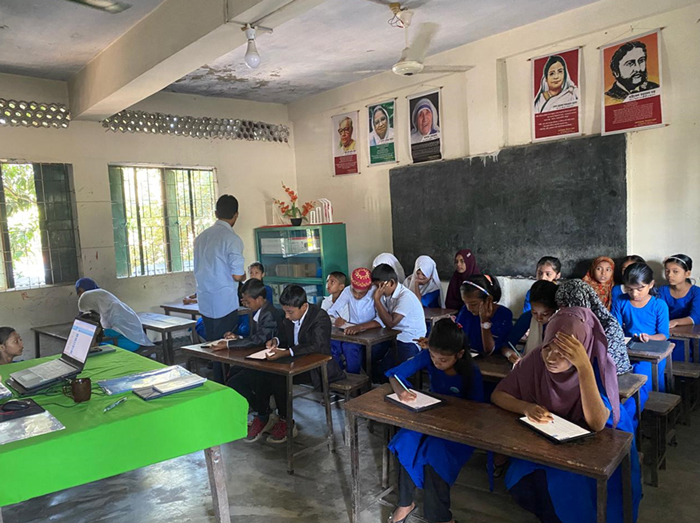
Mr. Tamzid: Many children in Bangladesh struggle with math and English. Proficiency in these subjects can significantly enhance their future opportunities. However, envisioning a hopeful future has been particularly challenging for children from environmentally disadvantaged backgrounds. Over the past year, I have observed remarkable changes in these children and have become to hope that they will acquire essential skills through the Kumon Method, enabling them to excel in the next phase of their lives after graduating from elementary school. I am grateful that BSEZ’s CSR project has provided underprivileged children with access to a high-quality education. BSEZ is making a substantial impact on the economy of this entire region, and I believe that the lives of local residents will continue to improve in the future.
■What brings me the greatest joy is that I can now accomplish things I was previously unable to do!
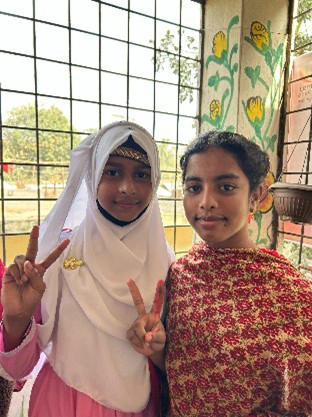
We asked two fifth-grade students who had studied the Kumon Method for a year what they thought of it. Below are some of their comments:
“I used to have difficulty reading numbers from one to ten, but now I can read up to one hundred, which makes me feel capable of learning.”
“I am happy and proud to hear my family and relatives say how great it is that I am learning on the tablet, even though they have never placed much importance on my studies at home before.”
“What brings me the greatest joy about studying in the Kumon program is that I can now accomplish things I was previously unable to do!”
■The Kumon Method embodies “quiet enthusiasm”
We also spoke with Ms. Hayata, who was assigned to BSEZ in October 2023 and oversaw this educational CSR project.
Q. What do you believe is the significance of this activity?
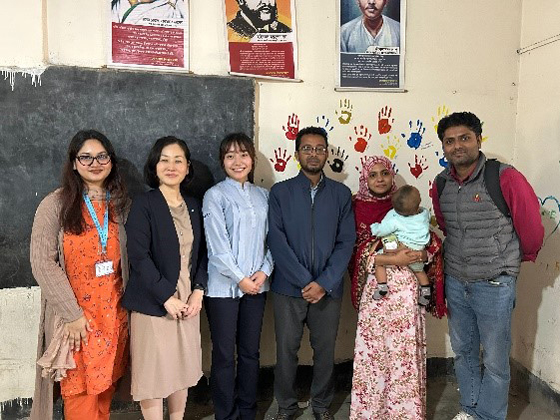
Ms. Hayata: I learned that some families of the children who attend this school used to farm on the industrial park property before the development of the BSEZ. However, they have transitioned to other jobs following the establishment of the BSEZ. It is these individuals who make this business possible and inspire me to believe that we must contribute to the surrounding community. I believe the significance of this initiative lies not only in enhancing the industrial park but also in giving back to the community, recognizing that the BSEZ can operate its business thanks to the support of the local residents.
Q. How do you feel about the Kumon program at Sonpara Elementary School?
Ms. Hayata: I am amazed at how focused the children are while learning through the Kumon Method. At school, regardless of when I enter the classroom, it is always noisy, making it difficult to discern whether the children are engaged in a lesson or playing. However, during Kumon study time, everyone is quietly focused on their work. I truly appreciate the effectiveness of the Kumon approach. The program offers excellent learning materials, and when I observe the children concentrating intently on these worksheets, I feel that Kumon fosters a “quiet enthusiasm” within them.
Q. Are there any students who have impressed you?
Ms. Hayata: One of the students was learning addition, but she was doing so incorrectly. Although she appeared confident in her problem-solving, her answers were marked as wrong. It seemed she had relied on her own logic to arrive at her conclusions. After her worksheets were graded, she would often question why her answers were incorrect. Eventually, she came to understand her mistakes and learned the correct methods for solving the problems. I believe that students become more capable of studying effectively after they grasp these processes.
Q. How do you envision the children at Sonpara Elementary School in the future?
Ms. Hayata: I believe that learning expands your potential. I was fortunate to study as much as I desired. I never faced limitations, nor was I ever told that I could not pursue my education because I was a girl. I feel incredibly blessed to have had the opportunity to learn freely. I hope that the children at Sonpara Elementary School will understand that with hard work, they can achieve their goals. I want them to experience the joy of accomplishing today what they could not do yesterday. By accumulating such experiences through Kumon, I hope that the children will broaden their potential.
Making BSEZ a Hub for Connection
Finally, we inquired with BSEZ President Kawachi about future prospects.
President Kawachi: The education CSR project will be conducted in collaboration with tenant companies operating within the BSEZ. By doing so, we aim to expand the project’s scope, such as increasing the number of children learning Kumon at Sonpara Elementary School and expanding the project to other elementary schools. As a next step, we aim to support tenant companies by establishing a vocational training school in the BSEZ to solve the local issue of inadequate job opportunities for graduates of elementary and junior high schools. Creating an environment where graduates of the vocational training school can find employment with tenant companies, we try to foster development alongside the local community rather than merely offering assistance.
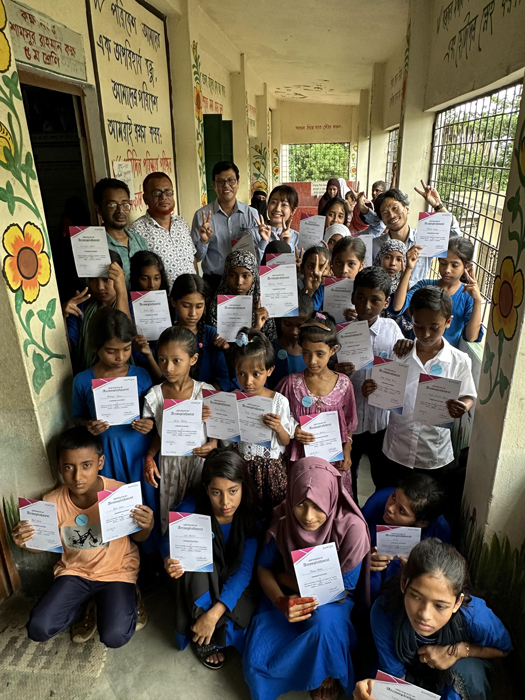
When I was assigned to Bangladesh, the entire area consisted of rice paddies. We developed an industrial park there, companies relocated, jobs were created, and a town emerged. Through this experience, I began to reflect deeply on the significant impact that industrial parks have on local communities and the weight of responsibility we bear. My desire to make BSEZ a place cherished by the surrounding community grew stronger.
I want to make BSEZ a hub to connect Bangladesh and Japan, local and global, the impoverished past and a prosperous future. Using the Sonpara Elementary School’s educational CSR project as a starting point, I aim to connect the children and this region to a future filled with hope.
関連リンク Bangladesh Special Economic Zone Limited (BSEZ) – Home Page

